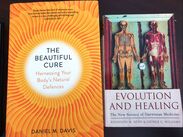Blank Title
Menu
Antibiotics: The war between hosts and pathogens has been on-going since the evolution of life on this planet - the new CRISPR technology that is revolutionising science and medicine is actually an ancient form of bacterial defence against viruses for example!
And the only reason life still exists (~3 billion years later) is because of the evolution of natural defence mechanisms! It wasn't until the 1940s* that mass-production of antibiotics started and while revolutionary, they also led to a false sense of security.
There are many, many natural defence mechanisms discovered, and many more yet to be identified. Nature really does hold the answer!
(*Howard Florey and Ernst Chain shared the 1945 Nobel Prize in Medicine with Alexander Fleming)
And the only reason life still exists (~3 billion years later) is because of the evolution of natural defence mechanisms! It wasn't until the 1940s* that mass-production of antibiotics started and while revolutionary, they also led to a false sense of security.
There are many, many natural defence mechanisms discovered, and many more yet to be identified. Nature really does hold the answer!
(*Howard Florey and Ernst Chain shared the 1945 Nobel Prize in Medicine with Alexander Fleming)
Natural disease resistance mechanisms
It is easy to forget that most individuals stay completely healthy, for the vast majority of the time. Under the process of natural selection, extant species survived over the course of evolution because of natural disease resistance mechanisms. These mechanisms stood these species in good stead even before the advent of antibiotics, and yet we still know so little about them.
Our research has identified novel host defence peptides in a range of livestock species (cattle, chickens, horses and sheep) which undoubtedly account for some of this natural defence. We are particularly interested in copy number variation (CNV) in these genes which are likely to explain differences in disease susceptibility between individuals.
However there are multiple other components of the immune response which enable individuals to remain healthy and identifying these offer novel avenues to tackle disease.
Our research has identified novel host defence peptides in a range of livestock species (cattle, chickens, horses and sheep) which undoubtedly account for some of this natural defence. We are particularly interested in copy number variation (CNV) in these genes which are likely to explain differences in disease susceptibility between individuals.
However there are multiple other components of the immune response which enable individuals to remain healthy and identifying these offer novel avenues to tackle disease.
Comparative Immunology
We have a lot yet to learn in science. Immunology research is most advanced in model organisms and we can leverage this progress to fast-track exciting developments in livestock and wildlife species.
Comparing the genomes (comparative genomics) and the immune systems between species can identify molecules and mechanisms which have been shaped over the course of evolution to best fight the insults that each species encounters.
For example, a specific type of T cell, known as the GD T cell holds exciting promise across a wide range of areas from novel therapeutics to vaccine design. In model organisms, these cells represent only ~5% of circulating lymphocytes, whereas in cattle, these cells can be as high as 60%!
We are interested in the selective forces that have given rise to these differences between the species because therein lies the clue as to how to harness these multi-functional cells to drive enhanced immunity.
We have recently been funded (by Science Foundation Ireland) to investigate if epigenetic suppression of these cells plays a role in the failure of diagnostics to detect all cattle infected with TB.
Comparing the genomes (comparative genomics) and the immune systems between species can identify molecules and mechanisms which have been shaped over the course of evolution to best fight the insults that each species encounters.
For example, a specific type of T cell, known as the GD T cell holds exciting promise across a wide range of areas from novel therapeutics to vaccine design. In model organisms, these cells represent only ~5% of circulating lymphocytes, whereas in cattle, these cells can be as high as 60%!
We are interested in the selective forces that have given rise to these differences between the species because therein lies the clue as to how to harness these multi-functional cells to drive enhanced immunity.
We have recently been funded (by Science Foundation Ireland) to investigate if epigenetic suppression of these cells plays a role in the failure of diagnostics to detect all cattle infected with TB.
Science + Nature = New solutions
Technological advances like gene editing (e.g. CRISPR) enable us to edit DNA to enhance phenotypes of interest. In terms of disease resistance, editing has already been used in cattle to enhance resistance to diseases including Mastitis and TB.
It is also critical that where rapid genetic progress can be made (for example with Genomic Selection) that we understand the knock-on consequences of selection for other phenotypes, including immunity. We cannot accurately measure many phenotypes and it is also important to remember that the phenotypes required today might not be the most desirable ones in livestock of the future!
It is also critical that where rapid genetic progress can be made (for example with Genomic Selection) that we understand the knock-on consequences of selection for other phenotypes, including immunity. We cannot accurately measure many phenotypes and it is also important to remember that the phenotypes required today might not be the most desirable ones in livestock of the future!
Site powered by Weebly. Managed by Letshost.ie




